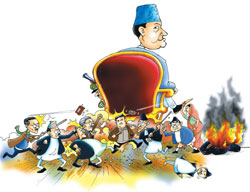|
|
The most-used word in Nepali newspaper headlines in 2006 was the adjective 'historic'. It was a historic Jana Andolan, a historic eight-point pact, parliament passed a slew of historic proclamations, then there was a historic comprehensive peace agreement and a historic interim constitution.
Indeed, the year 2006 was perhaps the most historic in our history. Never in Nepal's nearly 240-year existence has there been a year as momentous as this. Only 1816 came close, when the Gorkha Kingdom nearly lost its independence and had to cede over half its territory to the British after a bruising war.
For the first time since Prithbi Narayan Shah set out in 1770 on his conquests, our nation this year prepared to sever links with its founding dynasty. This chapter in our history isn't over yet but when it is, 2006 could possibly go down as the year the crown was knocked off. As it turned out, the person most responsible in helping bring down Nepal's monarchy was the monarch himself.
King Gyanendra never tried to hide his loathing for the leadership of the political parties and his allergy to the democratic process. His Feburary 2005 takeover was an attempt to go it alone, but a year later even his advisers admitted the king had fatally miscalculated the domestic and international reaction.
January 2006 began with Gyanendra's regime internationally isolated. The US, UK, and India had stopped military aid and even China was advising the king to relent.
The war wasn't going well, the army was in the crosshairs of human rights watchdogs, and the royal dictatorship had pushed the Maoists and the parties into an alliance.
The Maoists, ending a ceasefire, blockaded highways, raided Tansen and Thankot. On the streets, the slogans of the seven-party alliance changed from "democracy" to "peace" the people started to spill out into the streets spontaneously. A war-weary nation had rejected the king's strategy to rule with an iron fist.
The municipal polls in February turned out to be a farce, and not just because of the boycott by the parties. King Gyanendra went on a series of televised walkabouts and started believing his own propaganda, mistaking public curiosity for support. He tried to convert orthodox Hindu reverence for monarchy into political clout. But even as he flew by helicopter from Pokhara to Birganj for a VHP ceremony in early April, Kathmandu's streets were choked with burning tyres as pro-democracy protests closed the capital.
The rallies spread and got bigger, and the royal regime responded by declaring a curfew. Civil society activists, politicians and journalists who defied it were jailed. The media ignored censorship to report on the civil-disobedience and the protests soon spread nationwide. Doctors, journalists, lawyers, ordinary citizens and even civil servants joined in.
Crowds of up to 200,000 people started massing up on the Ring Road. Nepal had never seen people power on this scale. As the situation grew untenable, India dispatched royal in-law Karan Singh to convince the king to relent and on 21 April he went halfway. The parties initially accepted it, but soon realised they had misjudged the level of anger on the streets.
The protests that weekend were the biggest ever, and the army brass finally mustered the courage to tell the king they couldn't hold off the crowd without a major bloodbath. King Gyanendra got the message and announced the restoration of parliament just before midnight on 24 April.
The reinstated parliament moved quickly to pass a slew of proclamations to clip the king's wings, although it wasn't radical enough for the more vocal republicans at the gates. The Maoists felt left out of the process and exerted pressure to expedite power-sharing. The government and Maoists signed the eight-point agreement at Baluwatar, and the rest of 2006 was taken up by step-by-step moves to sign the peace accord, ink a tripartite agreement with the UN on arms management, and finalise the interim constitution.
There has been a ceasefire for the most of 2006, bringing enormous respite to ordinary Nepalis. It is hard to believe that just a year ago, up to 40 Nepalis were dying every week in the conflict. Even so, there is still widespread fear of continued forced recruitment by the Maoists, extortion, and labour militancy. It may take time for the comrades to give up their old ways.
The interim constitution, though flawed and contradictory, has made an ailing prime minister more powerful than even an absolute monarch. His to-do list for 2007 includes ensuring that local units of government dismantled by the Maoists are restored so the constituent assembly polls can be held on schedule. The interim parliament can sit within a month, but the Maoists will find it difficult to convince the parties and the international community to join the government without renouncing violence.
The Maoists may be out of the jungles, but Nepal is not yet out of the woods. As this week's riots in Nepalganj showed, representation and identity politics are getting mixed up with militancy. It was a lesson to members of the seven-party government not to play with fire. They shouldn't be competing with militant tarai separatists to force shutdowns in such a volatile climate. The country is tinder-dry and hotheads on the royal right would be only too happy to light a spark.
The April Uprising this year proved that a non-violent pro-democracy movement could achieve in three weeks what the Maoists couldn't with ten years of war and nearly 15,000 deaths. The message of the Nepali people to extremists of both the left and right was: violence doesn't solve anything and don't you dare take away our democracy again.
The biggest challenge in 2007 will be to keep demands for fair representation from boiling over into ethnic, religious or separatist violence. The constituent assembly polls will be a referendum on the monarchy and will polarise the electorate. It will need unity, wisdom and vigilance among all political forces to thwart potential peace-wreckers. 



